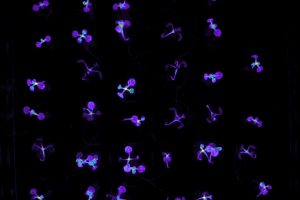
A major event in the life cycle of higher plants is the decision to flower. Many plants utilize seasonal changes in day length as a signal to flower, and higher plants utilize their circadian clocks to perceive these changes in day length.
Our lab has been involved in defining a molecular link between the circadian clock and day length-dependent regulation of flowering. A flowering time gene known as CONSTANS was identified a number of years ago and is regulated by the circadian clock. Our lab has been able to show that clock regulation of CONSTANS expression is the key to seasonal control of flowering in Arabidopsis.
We are currently extending these studies by comparing gene expression profiles under long days and short days in order to identify other components involved in perception of day length.

By combining molecular, genetic, and genomic approaches, our lab is beginning to define a number of molecular links between the circadian clock and rhythmic regulation of behavior and development. Analysis of circadian rhythms across multiple organisms affords a unique opportunity to define molecular controls over whole organism behaviors. These results will certainly provide targets for clinical and agricultural applications aimed at improving quality of life.
Plant Team Researchers: Marian Nohales, Matias Rugnone, Sabrina Sanchez, Shi (YuShi) Yu, Silvana Porco, Tong Liang, Yi (Jimmy) Li,
Clock Genes Keep Time to Daily Rhythm
Genes Moving to a Circadian Beat
Scientists Clone Gene that Regulates Circadian Rhythms in Plants